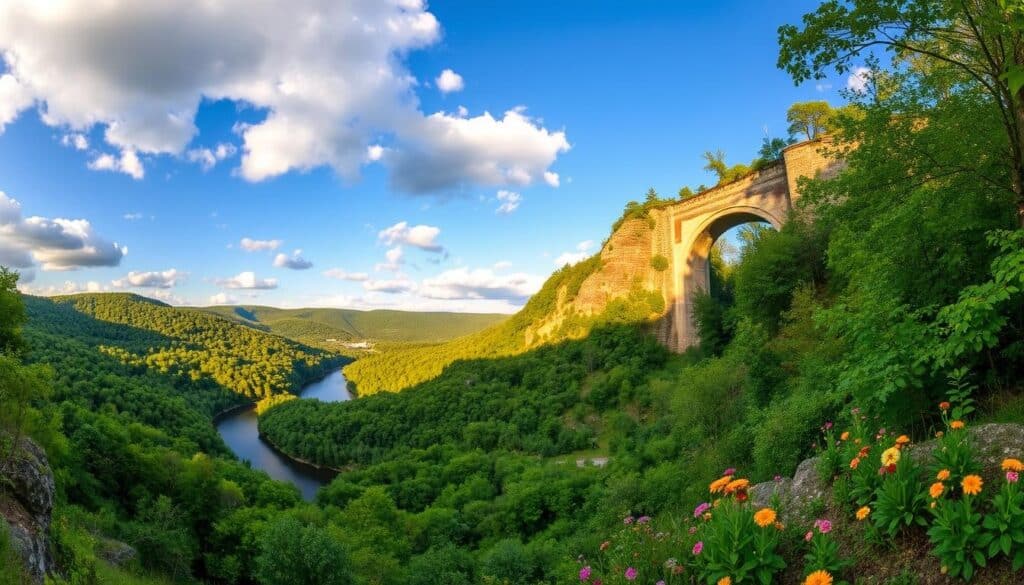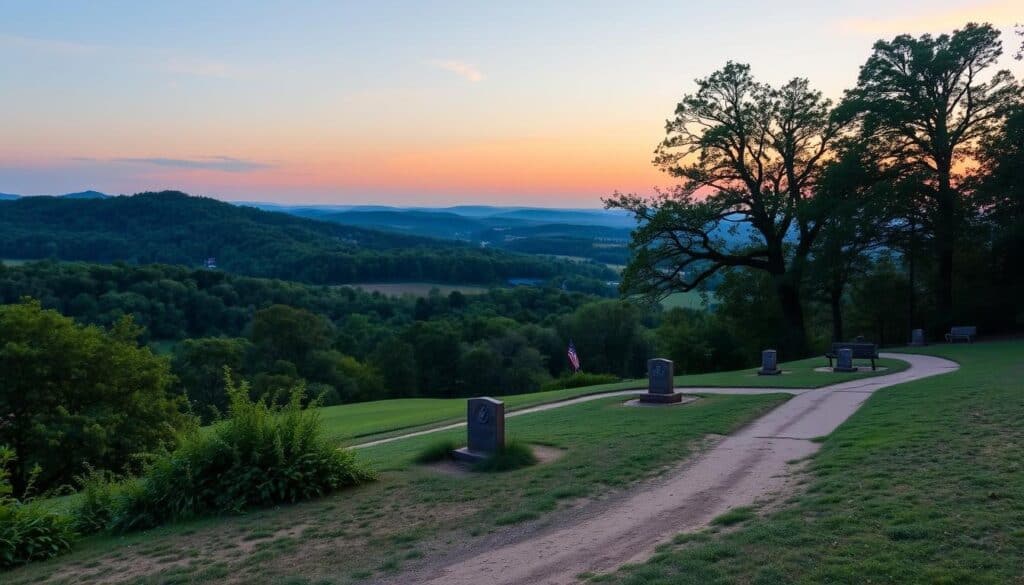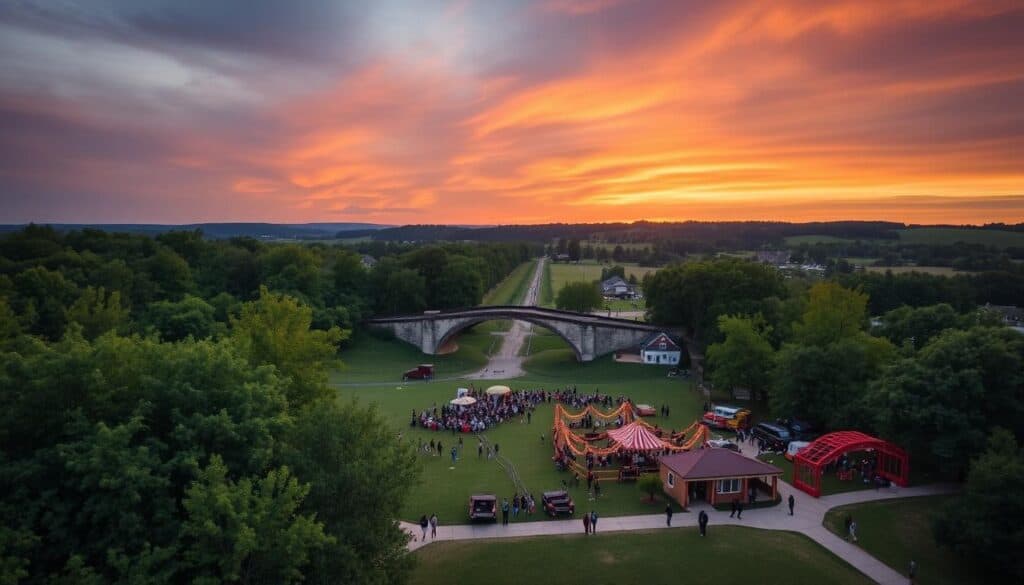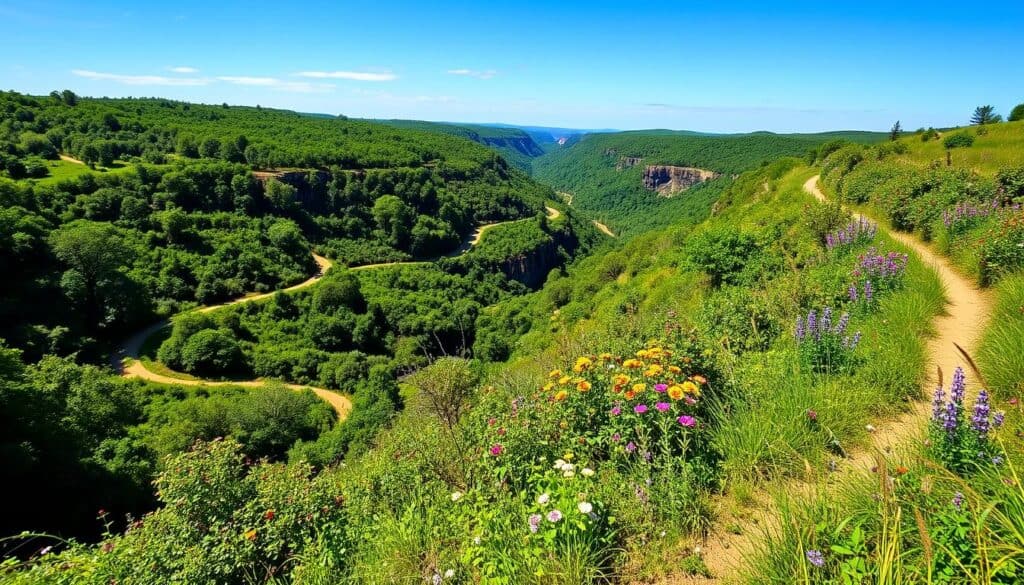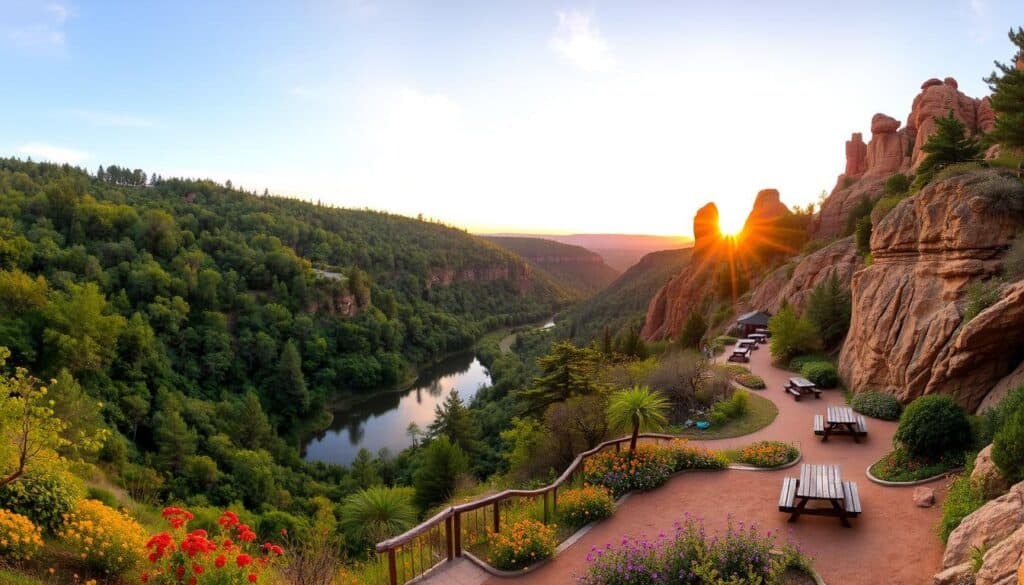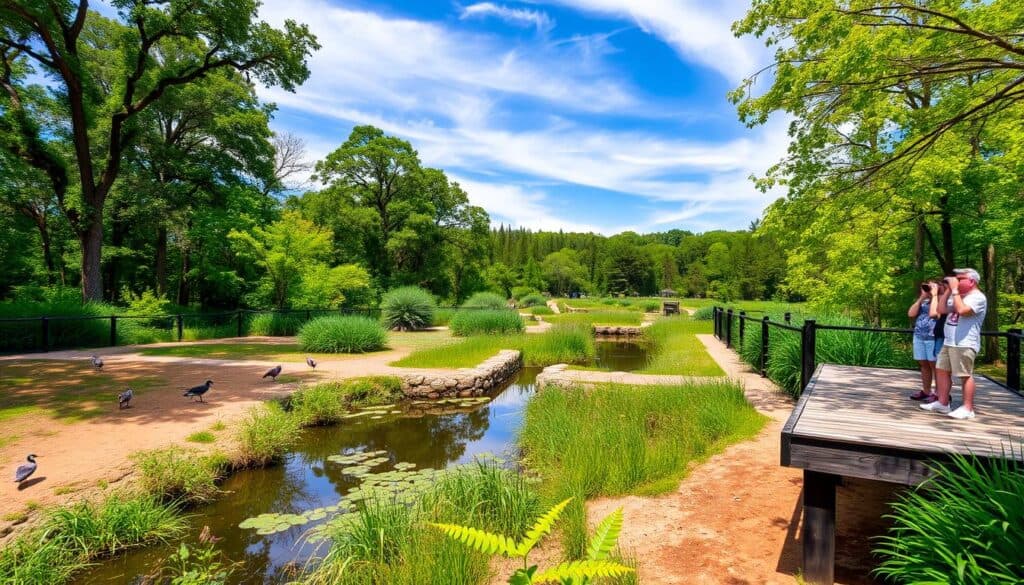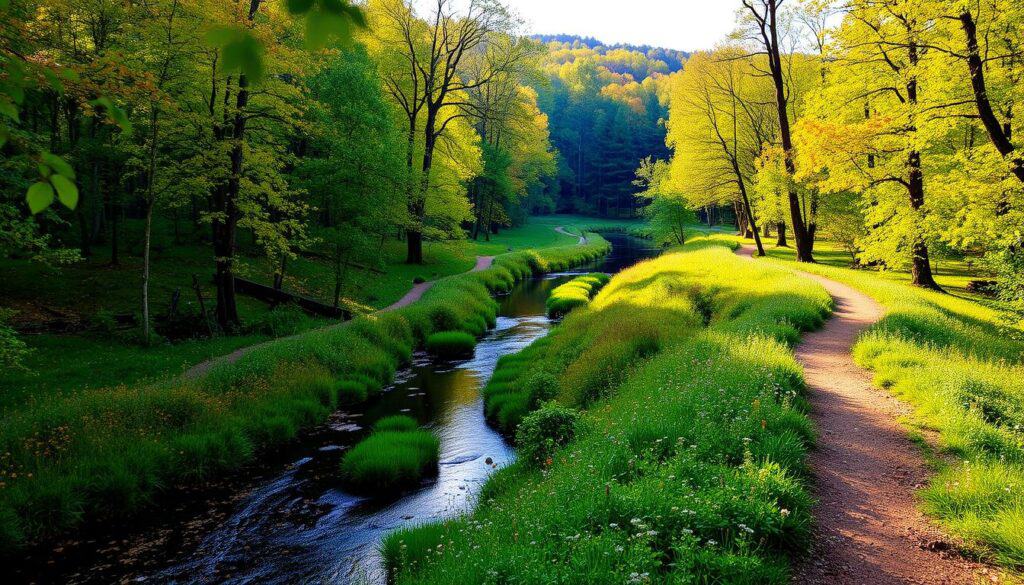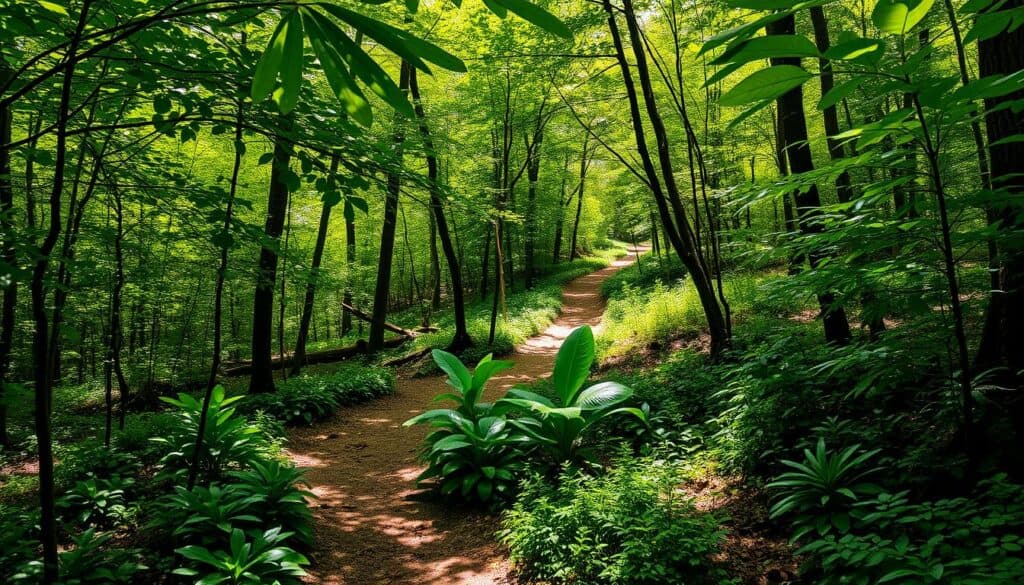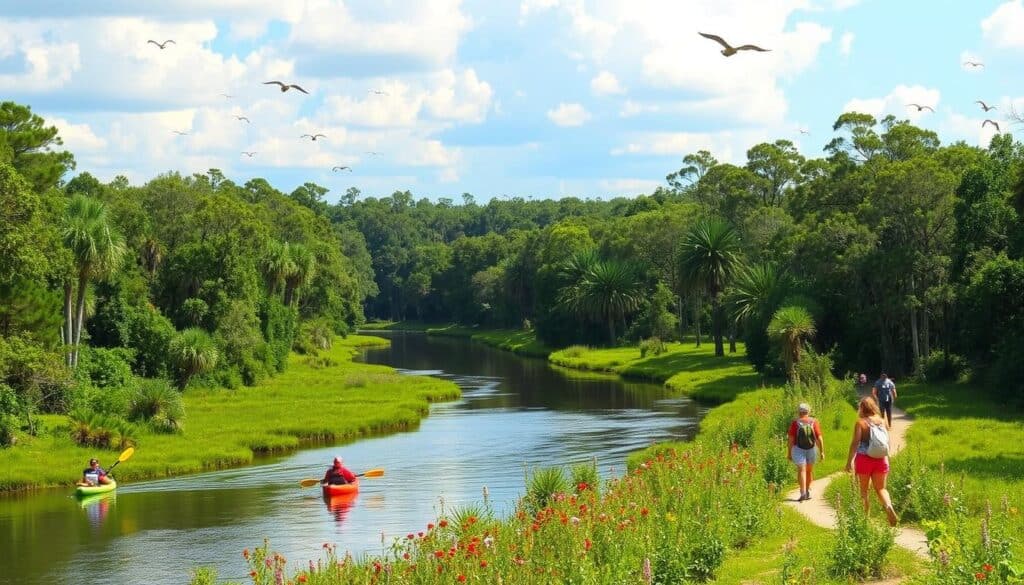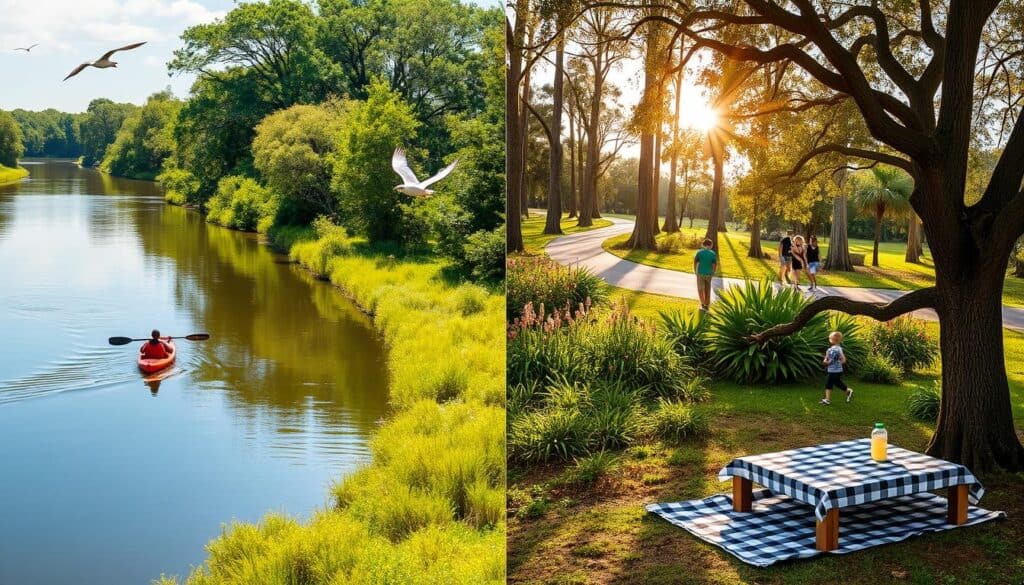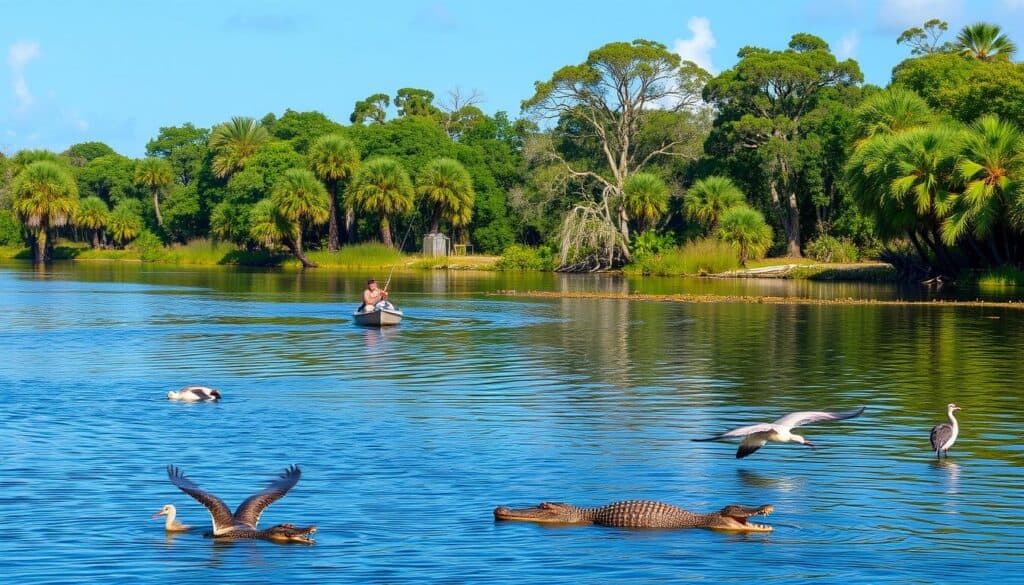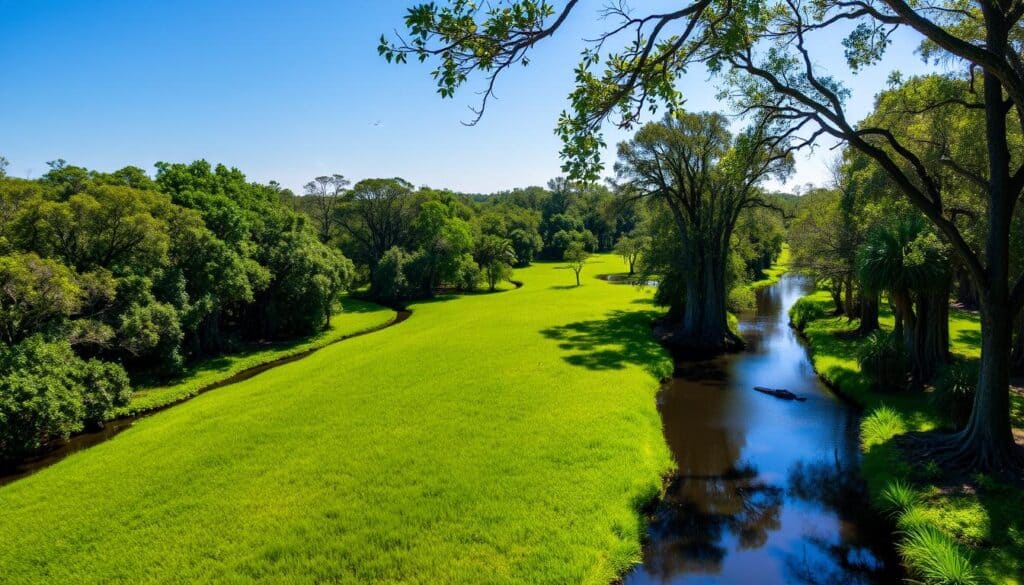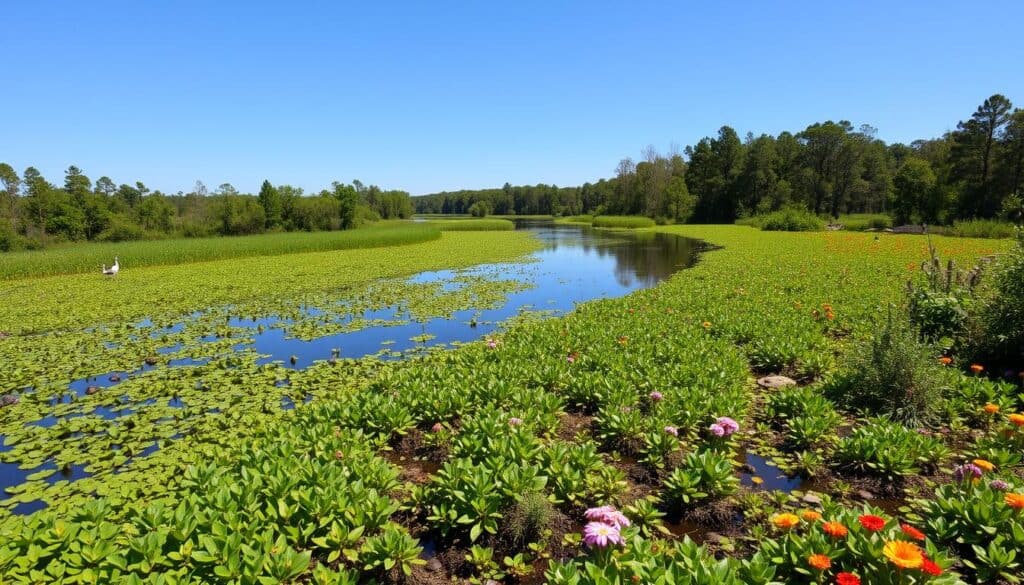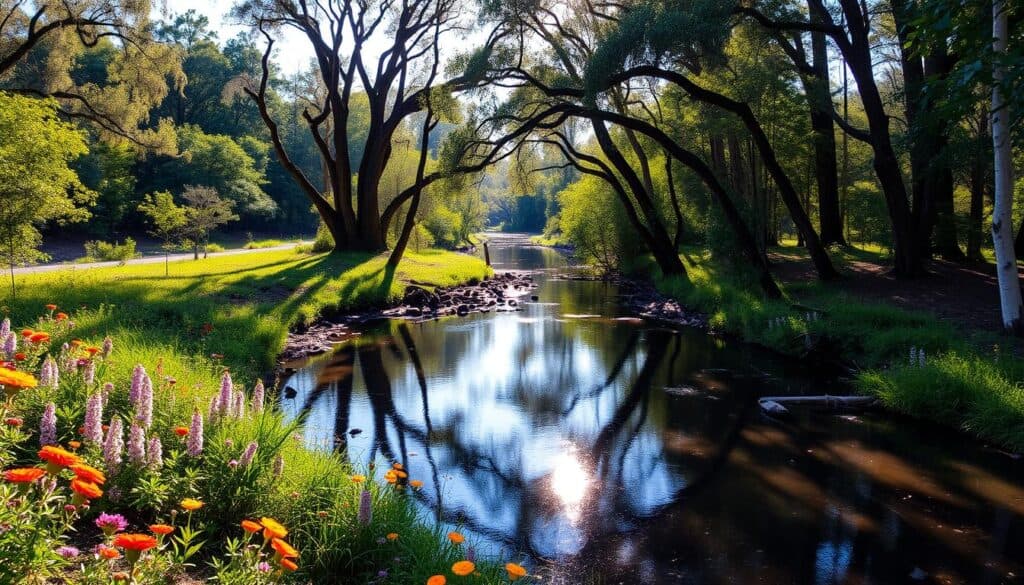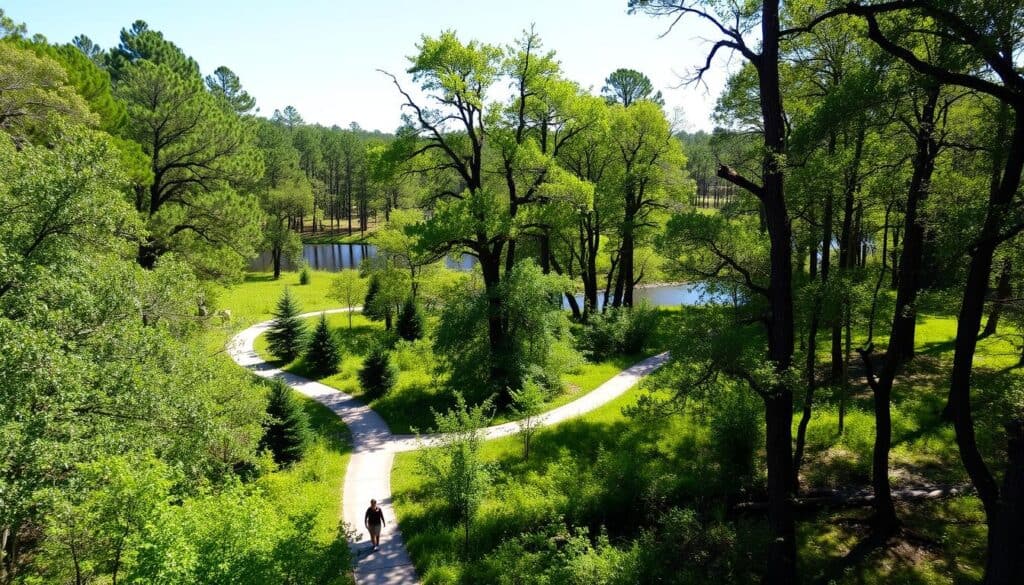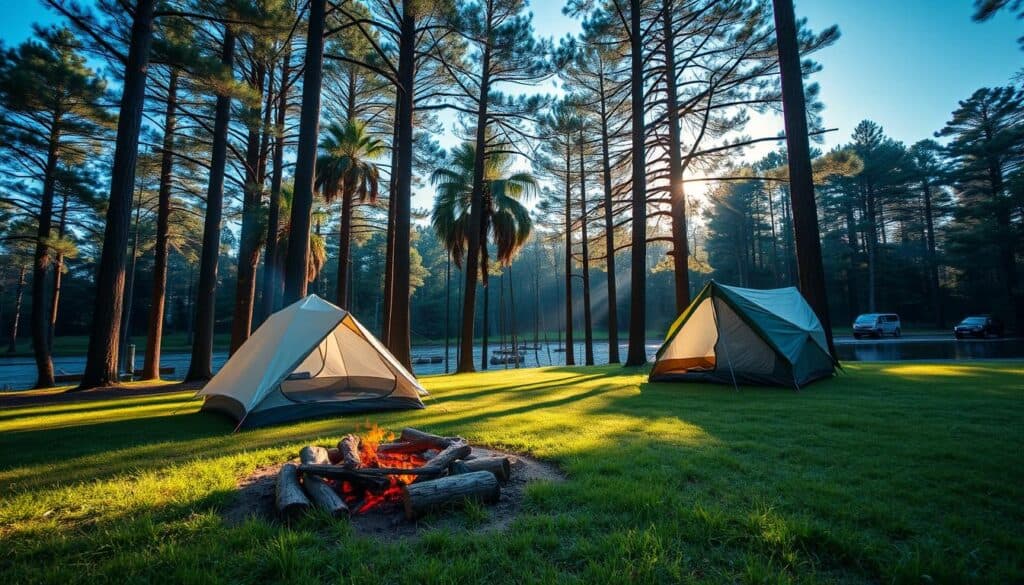Olustee Battlefield Historic State Park is a significant site in Florida’s history, marking the location of the largest Civil War battle in the state. The battle, which took place on February 20, 1864, involved over 10,000 cavalry, infantry, and artillery troops and resulted in 2,807 casualties. This park is one of the many Florida historic parks that showcase the state’s rich history, particularly its role in the Civil War battlefields.
Visitors to Olustee Battlefield Historic State Park can explore the battlefield and learn about its importance in the context of Civil War battlefields. The park’s historic site is dedicated to preserving the history of this significant event, making it an essential stop for those interested in Florida historic parks and the Civil War.
Key Takeaways
- Olustee Battlefield Historic State Park is the site of the largest Civil War battle in Florida.
- The battle involved over 10,000 troops and resulted in 2,807 casualties.
- The park is one of the many Florida historic parks that showcase the state’s role in the Civil War.
- Olustee Battlefield Historic State Park is dedicated to preserving the history of the Civil War battlefields.
- The park offers visitors a chance to explore the battlefield and learn about its importance in the context of Civil War battlefields.
- Annual reenactments of the Battle of Olustee have been taking place since 1977, featuring approximately 2,000 reenactors.
Introduction to Olustee Battlefield Historic State Park
Olustee State Park is a significant historical site in Florida, showcasing the state’s rich history and natural beauty. Established in 1912 as Florida’s first state historic site, the park has become a popular destination for those interested in history and the Civil War.
The park’s history dates back to the Civil War, when the largest battle in Florida took place on February 20, 1864. Today, visitors can explore the park’s museum, which features artifacts found on the site, and attend reenactments and other Olustee Battlefield events that bring the history of the battle to life.
As part of Florida state park history, Olustee State Park is classified as Florida’s first state park. The park’s natural communities, including mesic flatwoods, provide habitat for several clusters of the federally endangered red-cockaded woodpecker. With its unique blend of history and nature, Olustee State Park is a must-visit destination for anyone interested in Olustee State Park and its significance in American history.
The park offers a range of activities and amenities, including a museum, trails, and a visitor center. Visitors can also attend the annual reenactment of the Battle of Olustee, which attracts thousands of visitors each year. With its rich history and natural beauty, Olustee State Park is a unique and fascinating destination that showcases the best of Florida state park history and Olustee Battlefield events.
| Park Area | Acreage |
|---|---|
| Mesic Flatwoods | 549.89 acres |
| Basin Swamp | 26.64 acres |
| Depression Marsh | 4.62 acres |
History of the Battle of Olustee
The Battle of Olustee, a pivotal event in the Civil War, took place on February 20, 1864, in Baker County, Florida. This battle is significant in the context of Civil War battlefields and Florida state park history. The Union forces, led by General Truman A. Seymour, clashed with a large Confederate force, resulting in a significant defeat for the Union. The battle involved over 10,000 troops and resulted in 2,807 casualties.
The Olustee Battle reenactment, held annually on Presidents’ Day weekend, commemorates the sacrifice of the soldiers who fought in this battle. The reenactment is a key event in the Florida state park history, attracting thousands of reenactors from across the U.S. and overseas. The battle’s significance is still remembered today, with various events and activities taking place throughout the year to honor the soldiers who fought.
Overview of the Civil War in Florida
Florida played a crucial role in the Civil War, with several key battles taking place in the state. The Battle of Olustee was one of the largest battles fought in Florida, and its outcome had a significant impact on the war effort. The state’s strategic location and natural resources made it an important location for both the Union and Confederate forces.
Key Events of the Battle
The Battle of Olustee was a intense and bloody conflict, with both sides suffering heavy casualties. The Union forces were ultimately defeated, with 1,861 casualties, including 203 killed, 1,152 wounded, and 506 captured or missing. The Confederate forces suffered 949 casualties, including 93 killed, 848 wounded, and 8 captured or missing.

Notable Figures Involved
Several notable figures were involved in the Battle of Olustee, including General Truman A. Seymour, who led the Union forces, and General Joseph Finegan, who led the Confederate forces. The battle was a significant event in the Civil War, and its legacy continues to be remembered today through the Olustee Battle reenactment and other events.
| Date | Event | Location |
|---|---|---|
| February 20, 1864 | Battle of Olustee | Baker County, Florida |
| Presidents’ Day weekend | Olustee Battle reenactment | Olustee Battlefield Historic State Park |
The Park’s Location and Accessibility
Located in Sanderson, Florida, the Olustee Battlefield Historic State Park is easily accessible by car. Visitors can follow the directions provided on the park’s website to arrive at the park. The park is open daily from 8 am to sunset, and the Olustee Battlefield museum is open from 9 am to 5 pm.
The park offers various Olustee Battlefield events throughout the year, including the annual reenactment of the Battle of Olustee, which attracts history enthusiasts and families. The Olustee Battle anniversary is also commemorated with special events and activities.
Some of the key features of the park include:
- Well-tended trails that ensure ease of navigation for visitors of all ages and physical abilities
- A scenic environment with wildlife presence, making it a popular picnic area
- Accessibility features, including a wheelchair-accessible trail and restrooms
With its rich history and natural beauty, the Olustee Battlefield Historic State Park is a must-visit destination for anyone interested in learning about Florida’s Civil War legacy. Whether you’re attending an Olustee Battlefield event or simply exploring the park’s trails, you’re sure to have a memorable experience.
| Park Feature | Description |
|---|---|
| Park Hours | 8 am to sunset |
| Museum Hours | 9 am to 5 pm |
| Accessibility Features | Wheelchair-accessible trail and restrooms |
Key Attractions Within the Park
Olustee Battlefield Historic State Park offers a variety of attractions that allow visitors to explore the park’s history and natural beauty. The park is one of the many Florida historic parks that provide a glimpse into the state’s rich history. Located in northern Florida, Olustee Battlefield Historic State Park is a must-visit destination for anyone interested in Civil War battlefields.
Upon arrival, visitors can start their journey at the
The Visitor Center: Your Starting Point
, which provides information about the park’s history and offers a museum with artifacts found on the site. The park also features
Historic Markers and Signs
that provide insight into the battle and its significance. Visitors can also explore the park’s
Walking Trails and Areas of Interest
, which take them through the battlefield and offer a chance to reflect on the events that took place.
Some of the key attractions within the park include:
- Reenactments of the Battle of Olustee
- Guided tours of the battlefield
- Historic markers and signs
- Walking trails and areas of interest
Olustee Battlefield Historic State Park is a significant part of Civil War battlefields in the United States, and it is one of the many Florida historic parks that showcase the state’s history. Visitors can explore the park’s many attractions, including the visitor center, historic markers, and walking trails, to gain a deeper understanding of the Battle of Olustee and its significance in American history.
| Attraction | Description |
|---|---|
| Visitor Center | Provides information about the park’s history and offers a museum with artifacts |
| Historic Markers and Signs | Provide insight into the battle and its significance |
| Walking Trails and Areas of Interest | Take visitors through the battlefield and offer a chance to reflect on the events that took place |
Educational Opportunities at Olustee Battlefield
Olustee State Park offers a range of educational opportunities for visitors of all ages, providing a unique chance to learn about Florida state park history and the significance of the Battle of Olustee. The park’s guided tours and programs allow visitors to explore the battlefield and gain a deeper understanding of the events that took place there.
For teachers and students, the park provides a variety of resources, including lesson plans and activity sheets, to help integrate the history of the battle into their curriculum. Throughout the year, the park hosts Olustee Battlefield events, such as reenactments and living history programs, which bring the history of the battle to life.
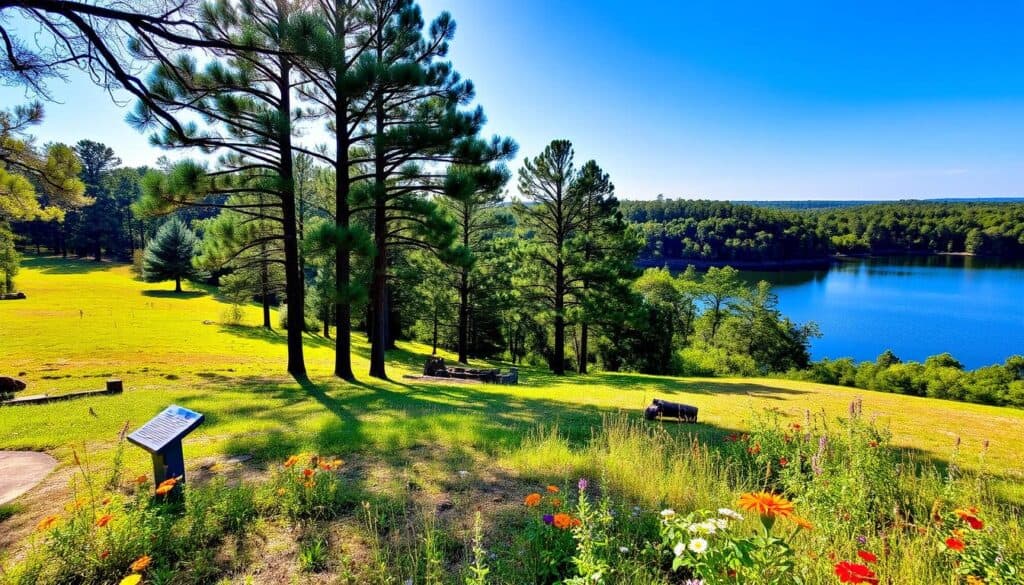
- Guided tours of the battlefield
- Living history programs and reenactments
- Lesson plans and activity sheets for teachers and students
These programs and resources provide a unique and engaging way to learn about the history of the Battle of Olustee and its significance inFlorida state park history. By visiting Olustee State Park, visitors can gain a deeper understanding of this important event and its impact on the state’s history.
Recreational Activities at the Park
Olustee Battlefield Historic State Park offers a variety of recreational activities that allow visitors to enjoy the park’s natural beauty. The park features hiking and nature trails that take visitors through the battlefield and offer a chance to reflect on the events that took place. Visitors can explore the park’s trails and enjoy the scenery, making it a great destination for outdoor enthusiasts.
Some of the recreational activities available at the park include:
- Hiking and nature trails
- Bird watching and wildlife viewing
These activities allow visitors to connect with nature and learn about the park’s history and significance. The park is also a great destination for those interested inCivil War battlefieldsandFlorida historic parks.
Visitors to Olustee Battlefield Historic State Park can enjoy the park’s natural beauty while also learning about its rich history. The park is a must-visit destination for anyone interested in Olustee Battlefield Historic State Park and its significance in American history.
Community Involvement and Volunteer Opportunities
Olustee State Park offers a range of community involvement and volunteer opportunities, allowing visitors to contribute to the park’s maintenance and conservation efforts. The Olustee Battlefield Citizens Support Organization (CSO) was founded in 1990 to support the park, and since then, it has played a vital role in promoting Florida state park history and preserving the legacy of Olustee Battlefield events.
Volunteers can participate in various activities, including park maintenance, event planning, and conservation projects. The CSO is a non-profit organization that relies on membership fees and donations to support its activities. By getting involved, volunteers can learn about the park’s history and natural beauty, while also meeting new people and making a difference in the community.
Some of the benefits of volunteering at Olustee State Park include:
- Opportunities to learn about Florida state park history and Olustee Battlefield events
- Chance to meet new people and make friends
- Ability to contribute to conservation efforts and make a difference in the community
Annually, the park hosts the largest Civil War reenactment in the Southeast, attracting over 2,000 reenactors. This event takes place during a weekend in February and is a significant part of Olustee Battlefield events. The CSO plays a crucial role in organizing this event, and volunteers are essential to its success.
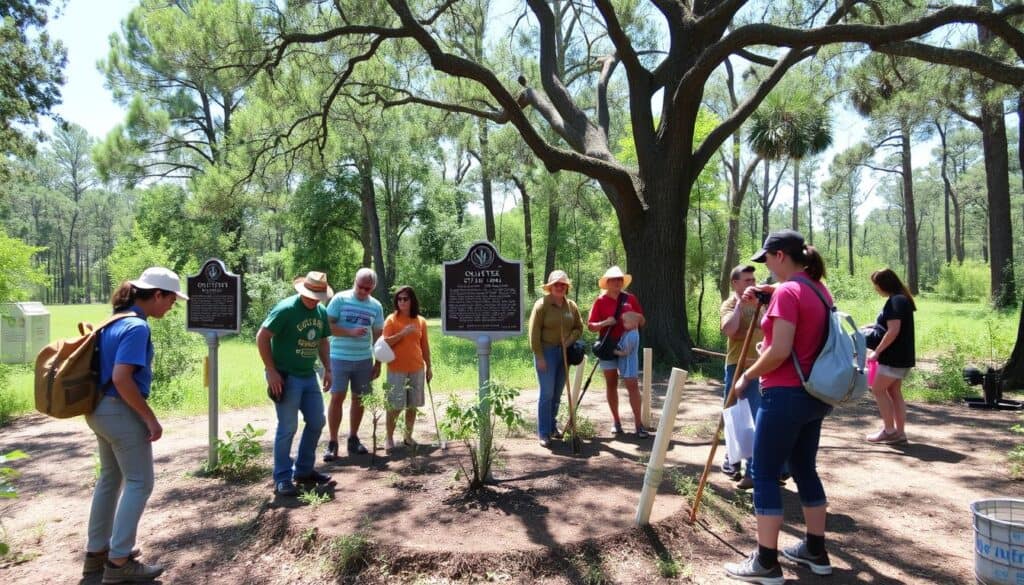
By volunteering at Olustee State Park, individuals can be part of a community that values preserving history and promoting conservation. With its rich Florida state park history and exciting Olustee Battlefield events, the park offers a unique and rewarding experience for volunteers.
| Category | Statistics |
|---|---|
| Total Number of CSO General Membership | 40 |
| Total Number of Board of Directors | 16 |
| Total Volunteer Hours for the Board of Directors | 2,034.50 hours |
Annual Events Celebrating Olustee’s Legacy
The Olustee Battlefield museum and surrounding park area host various events throughout the year to commemorate the Olustee Battle anniversary. One of the most notable events is the Olustee Battlefield Festival, which features living history programs, reenactments, and other activities that bring the history of the battle to life.
Some of the Olustee Battlefield events include reenactments, which offer a unique glimpse into the past and allow visitors to experience the sights and sounds of the battle. These events are a great way to learn about the history of the battle and the significance of the Olustee Battlefield museum.
Here are some of the events that take place at the Olustee Battlefield:
- Reenactments of the Battle of Olustee
- Living history programs
- Guided tours of the battlefield
- Special events and lectures
These events are a great way to experience the history of the Olustee Battlefield and learn about the significance of the Olustee Battle anniversary. The Olustee Battlefield museum and surrounding park area are a must-visit for anyone interested in history and the Civil War.
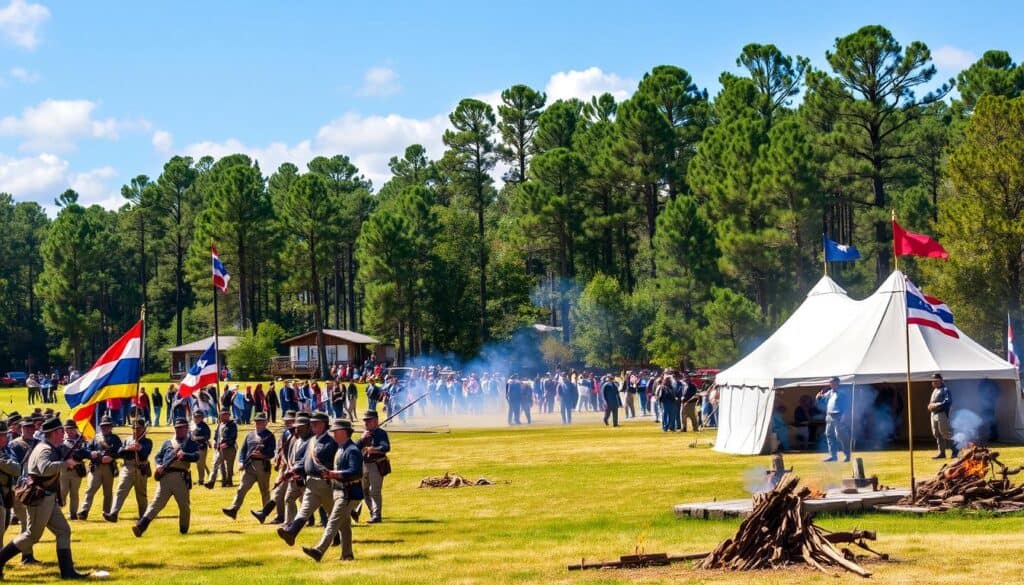
By attending these events, visitors can gain a deeper understanding of the battle and its significance, and appreciate the importance of preserving the Olustee Battlefield museum and surrounding park area.
| Event | Date | Description |
|---|---|---|
| Olustee Battlefield Festival | February | Living history programs, reenactments, and other activities |
| Reenactments | Throughout the year | Reenactments of the Battle of Olustee |
Conservation Efforts at the Park
Olustee Battlefield Historic State Park is committed to preserving the history and natural beauty of the park. The park’s conservation efforts focus on protecting the battlefield and its surroundings, as well as preserving the historic structures and artifacts found on the site.
Recent conservation projects have included the restoration of the park’s historic buildings and the development of new trails and interpretive programs. These efforts are crucial to ensuring that the history of the battle is preserved for future generations. The park is one of the six principal Civil War battlefield sites identified in Florida, with a total of 25,500 acres of historic tracts.
Some key statistics about the conservation efforts at Olustee Battlefield Historic State Park and other Florida historic parks include:
- 56% of the battlefield sites remain intact, with 5,064 acres of land protected by public or private entities.
- The National Park Service owns and manages 4,000 acres of battlefield lands at Saint John’s Bluff and Santa Rosa Island.
- Olustee Battlefield consists of 688 acres within the Osceola National Forest, with an additional 306 acres protected within the Forest Service’s Olustee Experimental Forest.
The conservation efforts at Olustee Battlefield Historic State Park are essential to preserving the history of the Civil War battlefields in Florida. By protecting the park’s natural and historic resources, we can ensure that the legacy of the battle is preserved for future generations to learn from and appreciate.
| Park Name | Acreage | Protection Status |
|---|---|---|
| Olustee Battlefield Historic State Park | 688 acres | Protected within Osceola National Forest |
| Saint John’s Bluff | 4,000 acres | Managed by National Park Service |
| Santa Rosa Island | 4,000 acres | Managed by National Park Service |
Visitor Information and Amenities
Olustee State Park, a significant part of Florida state park history, offers a range of amenities to ensure a comfortable and enjoyable visit. Located in Baker County, Florida, the park is open daily from 8 am to sunset, providing ample time to explore the grounds and learn about the Olustee Battlefield events that took place there.
For those interested in learning more about the park’s history, the museum is open from 9 am to 5 pm, offering a wealth of information about the Olustee Battlefield and its significance in Florida state park history. The park also features restrooms, picnic areas, and a gift shop, making it an ideal destination for families and history enthusiasts alike.
Park Hours and Admission Fees
The park’s visitor hours are from 8 am to sunset, with the museum open from 9 am to 5 pm. Admission to the park is free, making it an accessible destination for anyone interested in learning about Olustee Battlefield events and Florida state park history.
Facilities Available to Guests
Guests can take advantage of the park’s facilities, including guided tours and living history programs. These programs provide a unique insight into the Olustee Battlefield and its significance in American history. With its rich history and range of amenities, Olustee State Park is a must-visit destination for anyone interested in Florida state park history and Olustee Battlefield events.
Conclusion: Experience History at Olustee Battlefield
As you prepare to visit the Olustee Battlefield Historic State Park, a unique and captivating destination in Florida, you’ll have the opportunity to immerse yourself in the state’s rich Civil War legacy. This historic site offers a chance to step back in time and gain a deeper understanding of the pivotal Battle of Olustee, which played a significant role in the conflict.
Whether you’re a history enthusiast, nature lover, or simply seeking a remarkable day trip, Olustee Battlefield has something to offer. From exploring the informative visitor center and following the well-marked trails to attending the annual reenactment events, each visit promises an unforgettable experience. With admission to the park being free, it’s a budget-friendly way to connect with Florida’s past and appreciate the sacrifices made during the Civil War.
So, as you plan your visit to this remarkable Florida historic park, be sure to take advantage of the wealth of educational resources, recreational opportunities, and community events that make Olustee Battlefield a truly special destination. Whether you’re a local or a traveler, the park’s rich history and natural beauty are sure to leave a lasting impression. Visit Olustee Battlefield today and uncover the stories that shaped this unique corner of the Sunshine State.
FAQ
What is Olustee Battlefield Historic State Park?
Olustee Battlefield Historic State Park is a crucial site in Florida’s history, marking the location of the largest Civil War battle in the state. The park is dedicated to preserving the history of this significant event and offers visitors a chance to explore the battlefield and learn about its importance.
Why is the Battle of Olustee significant?
The Battle of Olustee was a pivotal event in the Civil War, marking a significant defeat for the Union forces in Florida. The battle involved over 10,000 troops and resulted in 2,807 casualties, making it the largest Civil War battle in the state.
Where is Olustee Battlefield Historic State Park located?
Olustee Battlefield Historic State Park is located in Sanderson, Florida, and is easily accessible by car. Visitors can follow the directions provided on the park’s website to arrive at the park.
What can visitors expect to see and do at the park?
Olustee Battlefield Historic State Park offers a variety of attractions and activities for visitors, including the visitor center and museum, historic markers and signs, and walking trails that take visitors through the battlefield. The park also hosts a variety of educational programs and events throughout the year.
How can visitors get involved with the park?
Olustee Battlefield Historic State Park offers a variety of community involvement and volunteer opportunities that allow visitors to get involved and make a difference. Visitors can contact the park’s volunteer coordinator to learn about the available opportunities.
What are some of the annual events hosted at the park?
Olustee Battlefield Historic State Park hosts a variety of annual events that celebrate the park’s legacy and commemorate the Battle of Olustee, including the Olustee Battlefield Festival and reenactments throughout the year.
How does the park work to preserve the history and natural beauty of the site?
Olustee Battlefield Historic State Park is committed to preserving the history and natural beauty of the park. The park’s conservation efforts focus on protecting the battlefield and its surroundings, as well as preserving the historic structures and artifacts found on the site.


